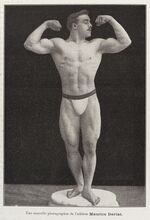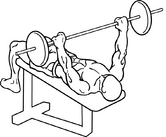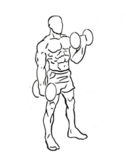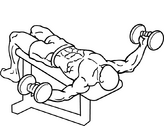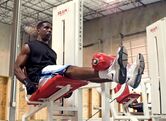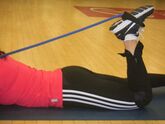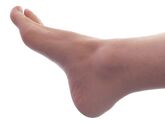Open Chain Exercise
Original Editor - Tarina van der Stockt
Top Contributors - Tarina van der Stockt, Aanal Bhuva, Kim Jackson, Evan Thomas, Lucinda hampton, WikiSysop, Naomi O'Reilly, Claire Knott and Wanda van Niekerk
Introduction[edit | edit source]
The Kinetic Chain is a method used to describe human movement, divided into either an open kinetic chain (OKC) or a closed kinetic chain(CKC). In an open kinetic chain, the part farthest from the body (e.g., foot or hand) moves freely and isn't fixed to an object.[1] In a closed kinetic chain, this part is stabilised. Both types of kinetic chain exercises provide their own benefits. The key advantage of OKC exercises is their capability to isolate a specific muscle.
Use of OKC VS CKC Exercises[edit | edit source]
A key benefit of open chain exercises: their superior ability to isolate specific muscles. This feature proves valuable in targeted muscle rehabilitation and training for sports that rely on open chain activities. For instance, activities like throwing a ball exemplify this concept.[3]
While certain practitioners may lean toward employing a specific type of kinetic chain exercise, studies suggest that both variations have utility in managing pain, facilitating post-surgical recovery, and enhancing athletic training.[3]
The utilisation of OCK and CKC exercises often varies among practitioners. Numerous studies have investigated the effects of these KC exercises, and some of the findings are reported below:
- A 2017 study on "The effects of open and closed kinetic chain exercises on the static and dynamic balance of the ankle joints in young healthy women" concluded that CKC exercises were more effective in improving balance.[4]
- A 2017 systematic review comparing the effectiveness of OKC versus CKC exercises following ACL reconstruction found no compelling evidence favoring one over the other.[5]
- A 2018 study examining shoulder muscle activation patterns in OCK versus CKC exercises revealed that OCK shoulder abduction is necessary to stabilise the head of the rotator cuff (RC) and axioscapular muscles. Hence, CKC exercises are better suited for earlier rehabilitation programs due to their inherent stability and reduced demand on RC. [6]However, a 2017 report concluded that OKC, CKC, and range of movement exercises all appear effective in producing short-term changes in pain and disability in patients with rotator cuff tendinopathy.[7]
- In a 2017 study titled "The impact of closed versus open kinetic chain exercises on osteoporotic femur neck and risk of fall in postmenopausal women," CKC exercises were deemed the most effective in mitigating the effects of the disease and reducing the risk of falls.[8]
| Characteristic |
Open kinetic chain exercises [1] | Example: seated knee extension[10] |
| Stress pattern |
Rotary |
The primary stress to the joint is rotation of the proximal tibia on the distal femur |
| Number of joint axes |
One primary |
Knee extension mainly occurs within the sagittal plane. |
| Nature of joint segments |
One stationary, other mobile |
|
| Number of moving joints |
Isolated joint motion |
The femur remains stationary while the tibia is moving |
| Planes of movement |
Singular plane |
|
| Muscular involvement |
Isolation of muscle group activation |
Minimal muscle co-contraction is used to do the movement |
| Movement pattern |
Often non-functional |
Biomechanical and Neurophysiological Factors[edit | edit source]
OKC exercises enable movement in the distal segment while being confined to a single joint. These exercises are commonly utilised to enhance strength and range of motion.[11]
Characteristics of typical non-weight bearing activities:[12]
- Increased distraction and rotational forces
- Increased acceleration forces
- Decreased resistance forces
- Increased deformation of joint and muscle mechanoreceptors
- Increased concentric acceleration and eccentric deceleration forces
- Promotion of functional activities
- Requires agonist-antagonist force couples
Open Chain Upper-Body Kinetic Exercises[edit | edit source]
- Bench press
- Biceps curl
- Chest-fly
- Lat pull down
- Triceps extensions
Open Chain Lower-Body Kinetic Exercises[edit | edit source]
- Seated leg extension
- Terminal knee extension exercises
- Hamstring curl
- Plantar / dorsiflexion (calf pumps)
Clinical Bottom Line[edit | edit source]
Many factors should be considered when deciding whether to use open kinetic chain exercises versus closed kinetic chain exercises. The patient's condition and stage of rehabilitation will assist the clinician in determining the appropriate exercise prescription.
References[edit | edit source]
- ↑ 1.0 1.1 Andrew TL. Closed Kinetic Chain Exercise. A Comprehensive Guide to Multiple-Joint Exercises. Journal of Chiropractic Medicine. 2002;1(4):200.
- ↑ Muscles and Motions. Open and Closed Kinetic chains. Available from: https://www.youtube.com/watch?v=UylQlk50gjg (last accessed 20-11-2013)
- ↑ 3.0 3.1 Ip D. Principles of Sports Rehabilitation. Orthopedic Rehabilitation, Assessment, and Enablement. 2007:219-35.
- ↑ Kim MK, Yoo KT. The effects of open and closed kinetic chain exercises on the static and dynamic balance of the ankle joints in young healthy women. Journal of physical therapy science. 2017;29(5):845-50.
- ↑ Jewiss D, Ostman C, Smart N. Open versus closed kinetic chain exercises following an anterior cruciate ligament reconstruction: a systematic review and meta-analysis. Journal of Sports Medicine. 2017 Aug 17;2017.
- ↑ Reed D, Cathers I, Halaki M, Ginn KA. Shoulder muscle activation patterns and levels differ between open and closed-chain abduction. Journal of science and medicine in sport. 2018 May 1;21(5):462-6.
- ↑ Heron SR, Woby SR, Thompson DP. Comparison of three types of exercise in the treatment of rotator cuff tendinopathy/shoulder impingement syndrome: A randomized controlled trial. Physiotherapy. 2017 Jun 1;103(2):167-73.
- ↑ Thabet AA, Alshehri MA, Helal OF, Refaat B. The impact of closed versus open kinetic chain exercises on osteoporotic femur neck and risk of fall in postmenopausal women. Journal of physical therapy science. 2017;29(9):1612-6.
- ↑ Institute education Open and closed chain exercises Available from:https://www.youtube.com/watch?v=_RZCz0e6I38 (last accessed 5.9.2019)
- ↑ http://www.physio-pedia.com/index.php/Closed_Chain_Exercise
- ↑ Sciascia A, Cromwell R. Kinetic chain rehabilitation: a theoretical framework. Rehabilitation research and practice. 2012 May 14;2012.
- ↑ Hyde TE, Gengenbach MS. Conservative management of sports injuries. Jones and Bartlett Learning; 2007. Available from: http://bit.ly/1OreHbG
